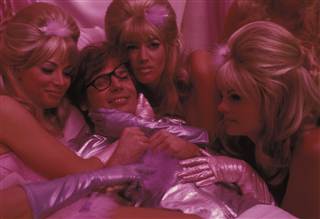Because if men aren’t front and center, that means it’s not important.
Yesterday, the editorial board of Columbia University’s student newspaper announced that it supports the “gender-neutral approach” being implemented this year at Columbia’s annual Take Back the Night march. Previously, the march organizers had a policy of allowing only women at the front of the march, acknowledging that women-only space for rape victims was important because of the traumatic nature of rape and the fact that almost all rapes are perpetrated by men on female victims. TBTN organizers had previously stated that
[t]he women’s space was created to ensure that female survivors, co-survivors, and allies could participate without feeling afraid, intimidated, or triggered in a co-gendered environment.
And indeed, the editorial board of the Spectator acknowledges that this reasoning is sound:
the presence of men at the front could possibly be traumatic and be a barrier in creating a safe space for the rape survivors.
We understand the reasoning behind this approach. As TBTN’s recent press release stated, a significantly higher percentage of perpetrators of sexual assault are male. Having women at the front of the march can be a visual symbol for rape’s gendered status. Moreover, while we cannot claim to fully grasp the psychology of rape, we understand that the trauma of some female rape survivors with male perpetrators—who constitute the majority of rape victims—can lead them to feeling threatened and emotionally unsafe in the presence of men.
Could they be more patronizing at the end there? I don’t think so. As academented, overly educated babies, none of which have apparently been raped themselves, they cannot fully grasp the psychology of rape — psychology is important, you see. As a patriarchal, pseudo-medical academic field, psychology is key to our understanding of the world, and key to our understanding of rape — not listening to rape survivors, who say that having men at the front of the march is triggering and intimidating. The editorial board at the Spectator might easily avail themselves of some learning on the issue however, if they wanted to, being at a major university and all. Lots of books there, although who knows what those books would actually say. About the psychology. Of rape.
And while the editorial board of the Spectator understand why female rape victims might feel threatened and emotionally unsafe in the presence of men, they simply don’t care.
Why?
Because gender. Yes! The editorial board at the Spectator apparently cannot tell the difference between sex and gender:
sexual assault is not just a women’s issue. Gender identity does not define who rapes or is raped. Men can be rape survivors, women can be perpetrators—and wherever oppression exists, sexual or otherwise, it is everyone’s issue. Having men at the front of the march can help illustrate that this issue transcends gender. Additionally, when some of the students who will be a valuable part of the march identify as transgender or reject gender identifications, it can become problematic to enforce a rule among gender lines. A gender-neutral approach is the only way for the march to be all-inclusive. By including more than just women at the front, TBTN is showing the many faces of rape survivors and allies in the community. As a show of inclusivity and solidarity, it can only strengthen the cause.
Rape is an issue that transcends gender alright: trans men are in danger of being raped and impregnated by men, and this is due entirely to their sex — they are female — and nothing to do with their gender at all. So opening up the front of the march to all FAABs including trans men would indeed show that rape transcends gender — but of course, this is not what the Columbia Spectator or the organizers of this year’s TBTN have in mind.
No, the Columbia Spectator and the organizers of TBTN are trying to tell us that rape — and specifically stranger rape — transcends sex, but of course that is not true. In fact, TBTN was specifically created to address the problem of male-on-female stranger rape, and women’s reasonable fear of that, where women were and are not free to walk the streets at night without fearing for their safety and their lives.
From the TBTN history page:
Why Take Back the Night?
A woman walks alone down a dark, deserted street. With every shadow she sees, and every sound she hears, her pounding heart flutters and skips a beat. She hurries her pace as she sees her destination become closer. She is almost there. She reaches the front door, goes inside, collects herself, and moves on forgetting, at least for tonight, the gripping fear that momentarily enveloped her life. This scene could have occurred anywhere last night, last year, or even 100 years ago. Historically, women faced the anxiety of walking alone at night and that is why Take Back the Night began.
That is the history of TBTN. TBTN was never meant to address the problem of “unwanted sex” as such, it was specifically designed to combat rape, that overtly political, interpersonal, biological and social oppression that male-bodied persons routinely visit on female-bodied persons cross-culturally and around the globe. Rape, where the victim often feels — and is given every reason in the world to believe — that she will be killed after her rapist penetrates her with his penis and ejaculates into her vagina. That she will never see her family again. That her children will be left without a mother, because she was raped and murdered by a man.
And where female rape victims are left to agonize for weeks — if they survive — whether they have been impregnated against their wills; and where they must live with the knowing that it could happen again. Because women are members of the rapeable class, and being raped once does not mean that it won’t happen again, and again, and again.
Men never have to deal with these consequences in their own lives, no matter what has happened to them, or who did it and why. No. These are the realities of rape, for female-bodied persons. And men deliver these consequences onto women by raping us.
Placing men and men’s concerns literally front and center at TBTN is ahistorical, acontextual, and the organizers know it will be damaging to women — and the editorial board of the Spectator and the organizers of this year’s TBTN are demonstrating that they do not care. That it will be damaging to women alone should be reason enough to not do it, but the truth is that there are other options that are apparently not even being explored; damaging women and disrupting women-only space is the first resort here, when it could be made the last resort — it could, if anyone cared even that much. But they don’t.
Whoever believes there is a need, could encourage male crime victims to start their own movement, instead of leaching off of the women who started and continued TBTN for themselves and for other women because men can’t seem to stop raping us. Let male victims start their own movement if it’s so important to them: let them amass their numbers in public and demand the kinds of change they want and need.
But do not let men — overwhelmingly the perpetrators of rape against both male and female victims — march in the front of, or take over, Take Back the Night. And definitely don’t do it because gender. That argument simply and obviously doesn’t hold any water at all.
Rape does not transcend sex. Rape is the use of sex and its attendant reproductive consequences as a tool of political oppression by men against women. Putting men literally front and center at this year’s TBTN is wrong.
 Are you sick and bloody tired of the male supremacist spin in mainstream news reporting, passing as neutrality and objectivity? Are you completely bored (or enraged) at the banality and woman-hatred displayed on every mainstream news outlet, in both the posts and the comments, whether they are left-leaning or right?
Are you sick and bloody tired of the male supremacist spin in mainstream news reporting, passing as neutrality and objectivity? Are you completely bored (or enraged) at the banality and woman-hatred displayed on every mainstream news outlet, in both the posts and the comments, whether they are left-leaning or right?









